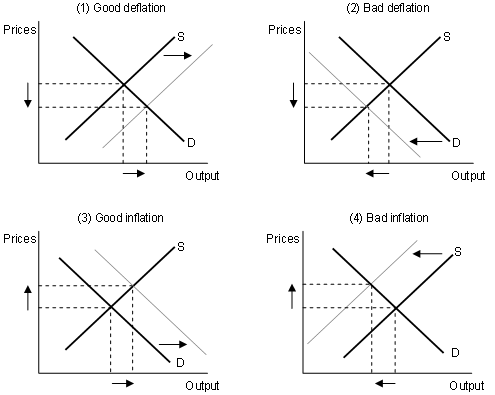In line with economic expansion, China's consumer price index, which fell 0.8% in 2002, turned around to mark a 3.2% increase in December 2003 and it is becoming clear that prices are on the rise. Meanwhile, the prices of some commodities such as iron ore are surging in global markets, pulled by the strong demand in China. Against such a backdrop, Japanese media attention has shifted from China-induced deflation to China-induced inflation. As was the case with China-induced deflation, the negative effects of China-induced inflation on the Japanese economy are being played up, but calm analysis will show that both views are incorrect.
So long as both inflation and deflation are price fluctuations, they can be perceived as the result of changes in demand factors such as economic cycles, and in supply factors such as productivity and input prices (positive and negative demand shocks and supply shocks). We can think of four scenarios - good deflation, bad deflation, good inflation and bad inflation - depending on whether price fluctuations in China are downward or upward, and whether production increases or decreases as a result ( diagram ). Reflecting the fact that the economies of Japan and China are in a complementary, rather than competitive, relationship, changes in prices and production in China induce changes in the same direction in Japan's prices and production in all four scenarios.
(1) Good deflation
As a result of positive supply shocks such as increased productivity in China (the shifting of the supply curve to the right), prices fall while output rises. In response, goods imported to Japan from China will become cheaper, and since parts exports to China will increase following the expansion of productivity there, China-bound exports will grow. Because the fall in prices of imports from China signifies a drop in production costs for Japanese companies, it is a factor that, together with the rise in exports to China, helps Japan's output grow (as is the case with China, Japan's supply curve will shift to the right). Of course, firms that compete with China will be adversely affected because demand will shift to China, but because the extent to which Japan and China compete with each other is still small, the scale of this negative impact will on the whole still be limited.
(2) Bad deflation
As a result of negative demand shocks such as an economic slowdown in China (the shift of the demand curve to the left), prices and output both fall there. In Japan, the subsequent decrease in exports to China will be reflected by drops in both output and prices (as is the case with China, Japan's demand curve will shift to the left). Of course, because imports from China will become cheaper, production costs at companies will fall and an increase in output can be expected. However, this "price effect" will probably be relatively smaller than the "income effect" of the economic downturn in China.
(3) Good inflation
Owing to positive demand shocks such as economic expansion in China (the shift of the demand curve to the right), prices (and as a result, prices on global commodity markets) and output both rise. Reflecting the growth in China-bound exports due to increased demand in China, production and prices in Japan will also rise (as in China's case, Japan's demand curve will shift to the right). Of course, the surge in prices of imports from China (as well as the prices of raw materials procured from other countries) will cause the production costs of companies to increase, and this may offset output increase to a certain extent. However, compared to the "income effect" of economic expansion in China, this "price effect" is likely to be relatively small.
(4) Bad inflation
Due to negative supply shocks such as the outbreak of SARS - severe acute respiratory syndrome - (the shift of the supply curve to the left), prices in China will rise, but production will decrease. Reflecting this, Japan's imports from China will become more expensive, and exports to China will fall. The rise in prices of imports from China signifies an increase in production costs for Japanese firms, and together with the decline in China-bound exports becomes a factor that reduces output in Japan (as in the case of China, Japan's supply curve shifts to the left). While some firms that are in a competitive relationship with China will be able to expand their exports, on the whole this will only take place on a limited scale, because the extent to which the two countries compete with each other is still limited.
Amid all this, we may say that Japan is simultaneously experiencing both "good deflation" brought about by a rise in productivity in China and "good inflation" induced by stronger economic growth. As can be seen by robust exports to China and the sustained improvement in Japan's terms of trade vis-a-vis China, China's advancement is serving as a tailwind for Japan and it is indeed a win-win game.



